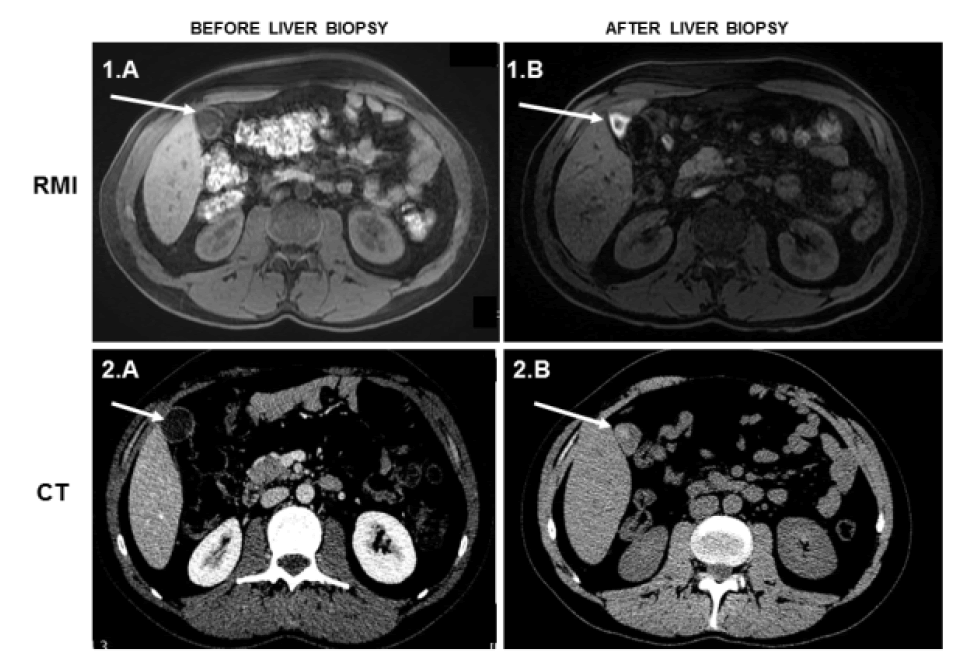Clinical images Open Access
Haemobilia Following Percutaneous Liver Biopsy
Sophie Georgin-Lavialle1*, William Curtis1, Anne Hernigou2, Brigitte Ranque2, Jacques Pouchot1and Amélie Passeron1
1Internal Medicine Service, Paris
2Department of Radiology, Paris Descartes University, Paris
- *Corresponding Author:
- Sophie Georgin-Lavialle
Internal Medicine Service
Georges Pompidou European Hospital
20 rue Leblanc, 75015 Paris
Tel : 01 56 01 72 04
Fax: 01 56 01 71 46
E-mail: sophie.georgin-lavialle@tnn.aphp.fr
Received date: November 25, 2014; Accepted date: November 26, 2014; Published date: December 02, 2014
Citation: Georgin-Lavialle S, Curtis W, Hernigou A, Ranque B, Pouchot J, et al. (2014) Haemobilia Following Percutaneous Liver Biopsy. J Gastroint Dig Syst 4:i101. doi:10.4172/2161-069X.1000i101
Copyright: © 2014 Georgin-Lavialle S, et al. This is an open-access article distributed under the terms of the Creative Commons Attribution License, which permits unrestricted use, distribution, and reproduction in any medium, provided the original author and source are credited.
Visit for more related articles at Journal of Gastrointestinal & Digestive System
A 32 years old man, previously followed for chronic alcoholic pancreatitis underwent a percutaneous liver biopsy for a suspect liver image. At that time, gallbladder had a normal aspect on MRI (hyposignal, panel 1A) and on CT (hypodensitiy, panel 2A). Histological examination of the tumour biopsy revealed a hepatocellular carcinoma in an otherwise healthy liver. Ten days after biopsy, he suddenly felt intense right-sided hypochondriac pain with liver enzyme elevation (15N), suggesting biliary colic. New imaging detected haemobilia (hypersignal on RMI, panel 1B and hyperdensity on CT, panel 2B). Pain and cytolysis were spontaneously regressive under antalgic treatment. A digestive echoendoscopy performed 5 days later revealed no gallstone.
Hemobilia denotes bleeding to the biliary tree, resulting from the pathological connection between a vessel and the biliary system. Most common causes are iatrogenic injuries such as in our patient. Haemobilia is rare but is a challenging radiologic diagnosis.

Relevant Topics
- Constipation
- Digestive Enzymes
- Endoscopy
- Epigastric Pain
- Gall Bladder
- Gastric Cancer
- Gastrointestinal Bleeding
- Gastrointestinal Hormones
- Gastrointestinal Infections
- Gastrointestinal Inflammation
- Gastrointestinal Pathology
- Gastrointestinal Pharmacology
- Gastrointestinal Radiology
- Gastrointestinal Surgery
- Gastrointestinal Tuberculosis
- GIST Sarcoma
- Intestinal Blockage
- Pancreas
- Salivary Glands
- Stomach Bloating
- Stomach Cramps
- Stomach Disorders
- Stomach Ulcer
Recommended Journals
Article Tools
Article Usage
- Total views: 15114
- [From(publication date):
December-2014 - Jul 09, 2025] - Breakdown by view type
- HTML page views : 10465
- PDF downloads : 4649
